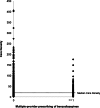Provider Patient-Sharing Networks and Multiple-Provider Prescribing of Benzodiazepines
- PMID: 26187583
- PMCID: PMC4720655
- DOI: 10.1007/s11606-015-3470-8
Provider Patient-Sharing Networks and Multiple-Provider Prescribing of Benzodiazepines
Erratum in
-
Erratum to: Provider patient-sharing networks and multiple-provider prescribing of benzodiazepines.J Gen Intern Med. 2016 May;31(5):588. doi: 10.1007/s11606-015-3533-x. J Gen Intern Med. 2016. PMID: 26514839 Free PMC article. No abstract available.
Abstract
Background: Prescription benzodiazepine overdose continues to cause significant morbidity and mortality in the US. Multiple-provider prescribing, due to either fragmented care or "doctor-shopping," contributes to the problem.
Objective: To elucidate the effect of provider professional relationships on multiple-provider prescribing of benzodiazepines, using social network analytics.
Design: A retrospective analysis of commercial healthcare claims spanning the years 2008 through 2011. Provider patient-sharing networks were modelled using social network analytics. Care team cohesion was measured using care density, defined as the ratio between the total number of patients shared by provider pairs within a patient's care team and the total number of provider pairs in the care team. Relationships within provider pairs were further quantified using a range of network metrics, including the number and proportion of patients or collaborators shared.
Main measures: The relationship between patient-sharing network metrics and the likelihood of multiple prescribing of benzodiazepines.
Participants: Patients between the ages of 18 and 64 years who received two or more benzodiazepine prescriptions from multiple providers, with overlapping coverage of more than 14 days.
Results: A total of 5659 patients and 1448 provider pairs were included in our study. Among these, 1028 patients (18.2 %) received multiple prescriptions of benzodiazepines, involving 445 provider pairs (30.7 %). Patients whose providers rarely shared patients had a higher risk of being prescribed overlapping benzodiazepines; the median care density was 8.1 for patients who were prescribed overlapping benzodiazepines and 10.1 for those who were not (p < 0.0001). Provider pairs who shared a greater number of patients and collaborators were less likely to co-prescribe overlapping benzodiazepines.
Conclusions: Our findings demonstrate the importance of care team cohesion in addressing multiple-provider prescribing of controlled substances. Furthermore, we illustrate the potential of the provider network as a surveillance tool to detect and prevent adverse events that could arise due to fragmentation of care.
Keywords: drug overdose; prescribing patterns; social networks.
Figures



References
-
- Centers for Disease Control and Prevention (CDC) CDC grand rounds: prescription drug overdoses—a U.S. epidemic. MMWR Morb Mortal Wkly Rep. 2012;61:10–3. - PubMed
Publication types
MeSH terms
Substances
Grants and funding
LinkOut - more resources
Full Text Sources
Other Literature Sources

